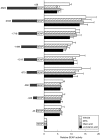Long-chain unsaturated fatty acids reduce the transcriptional activity of the rat follicle-stimulating hormone β-subunit gene
- PMID: 26853521
- PMCID: PMC4848577
- DOI: 10.1262/jrd.2015-138
Long-chain unsaturated fatty acids reduce the transcriptional activity of the rat follicle-stimulating hormone β-subunit gene
Abstract
Here, we assessed the effects of long-chain fatty acids (LCFAs) and the LCFA receptor agonist GW9508 on the transcription of the gonadotropin subunit genes Cga, Lhb and Fshb because LCFA receptor GPR120 was observed in mouse gonadotropes in our recent study. A transcription assay using LβT2 cells demonstrated that LCFAs, oleic acid, α-linolenic acid, docosahexaenoic acid and palmitate, repressed the expression of Cga, Lhb, and Fshb at concentrations between 50 and 100 µM. On the other hand, treatment with 10 µM unsaturated LCFAs, oleic acid, α-linolenic acid and docosahexaenoic acid, repressed only Fshb expression, while the same dose of a saturated LCFA, palmitate, had no effect on the expression of gonadotropin subunit genes. Furthermore, GW9508 did not affect promoter activity. Next, we examined deletion mutants of the upstream region of Fshb and found that the upstream regulatory region (-2824 to -2343 bp) of Fshb was responsible for the notable repression by 10 µM unsaturated LCFAs. Our results suggest that the upstream region of Fshb is susceptible to unsaturated LCFAs. In addition, unsaturated LCFAs play a role in repressing Fshb expression through the distal -2824 to -2343 bp region, which might be independent of the LCFA receptor GPR120 pathway.
Figures



Similar articles
-
Gpr120 mRNA expression in gonadotropes in the mouse pituitary gland is regulated by free fatty acids.J Reprod Dev. 2020 Jun 12;66(3):249-254. doi: 10.1262/jrd.2019-166. Epub 2020 Feb 28. J Reprod Dev. 2020. PMID: 32115468 Free PMC article.
-
Unsaturated fatty acids disrupt Smad signaling in gonadotrope cells leading to inhibition of FSHβ gene expression.Endocrinology. 2014 Feb;155(2):592-604. doi: 10.1210/en.2013-1833. Epub 2013 Nov 18. Endocrinology. 2014. PMID: 24248462
-
AMP-activated protein kinase activation reduces the transcriptional activity of the murine luteinizing hormone β-subunit gene.J Reprod Dev. 2020 Apr 10;66(2):97-104. doi: 10.1262/jrd.2019-143. Epub 2019 Dec 9. J Reprod Dev. 2020. PMID: 31813919 Free PMC article.
-
Mechanisms for pulsatile regulation of the gonadotropin subunit genes by GNRH1.Biol Reprod. 2006 Jun;74(6):993-8. doi: 10.1095/biolreprod.105.049049. Epub 2006 Feb 15. Biol Reprod. 2006. PMID: 16481592 Review.
-
Genomics and genetics of gonadotropin beta-subunit genes: Unique FSHB and duplicated LHB/CGB loci.Mol Cell Endocrinol. 2010 Nov 25;329(1-2):4-16. doi: 10.1016/j.mce.2010.04.024. Epub 2010 May 19. Mol Cell Endocrinol. 2010. PMID: 20488225 Free PMC article. Review.
Cited by
-
Gpr120 mRNA expression in gonadotropes in the mouse pituitary gland is regulated by free fatty acids.J Reprod Dev. 2020 Jun 12;66(3):249-254. doi: 10.1262/jrd.2019-166. Epub 2020 Feb 28. J Reprod Dev. 2020. PMID: 32115468 Free PMC article.
-
Transcription of follicle-stimulating hormone subunit genes is modulated by porcine LIM homeobox transcription factors, LHX2 and LHX3.J Reprod Dev. 2016 Jun 17;62(3):241-8. doi: 10.1262/jrd.2015-163. Epub 2016 Feb 8. J Reprod Dev. 2016. PMID: 26853788 Free PMC article.
-
Enhancement of Female Rat Fertility via Ethanolic Extract from Nigella sativa L. (Black Cumin) Seeds Assessed via HPLC-ESI-MS/MS and Molecular Docking.Molecules. 2024 Feb 5;29(3):735. doi: 10.3390/molecules29030735. Molecules. 2024. PMID: 38338478 Free PMC article.
-
Activation of GPR40 Suppresses AGE-Induced Reduction of Type II Collagen and Aggrecan in Human SW1353 Chondrocytes.Drug Des Devel Ther. 2020 Jun 15;14:2371-2379. doi: 10.2147/DDDT.S239273. eCollection 2020. Drug Des Devel Ther. 2020. PMID: 32606604 Free PMC article.
-
Effects of dietary Enteromorpha powder on reproduction-related hormones and genes during the late laying period of Zi geese.Anim Biosci. 2021 Mar;34(3):457-462. doi: 10.5713/ajas.20.0368. Epub 2020 Aug 30. Anim Biosci. 2021. PMID: 32898960 Free PMC article.
References
-
- Pierce BN, Stackpole CA, Breen KM, Clarke IJ, Karsch FJ, Rivalland ET, Turner AI, Caddy DJ, Wagenmaker ER, Oakley AE, Tilbrook AJ. Estradiol enables cortisol to act directly upon the pituitary to suppress pituitary responsiveness to GnRH in sheep. Neuroendocrinology 2009; 89: 86–97. - PubMed
-
- Rodriguez-Pacheco F, Martinez-Fuentes AJ, Tovar S, Pinilla L, Tena-Sempere M, Dieguez C, Castaño JP, Malagon MM. Regulation of pituitary cell function by adiponectin. Endocrinology 2007; 148: 401–410. - PubMed
MeSH terms
Substances
LinkOut - more resources
Full Text Sources
Other Literature Sources
Molecular Biology Databases
Research Materials

